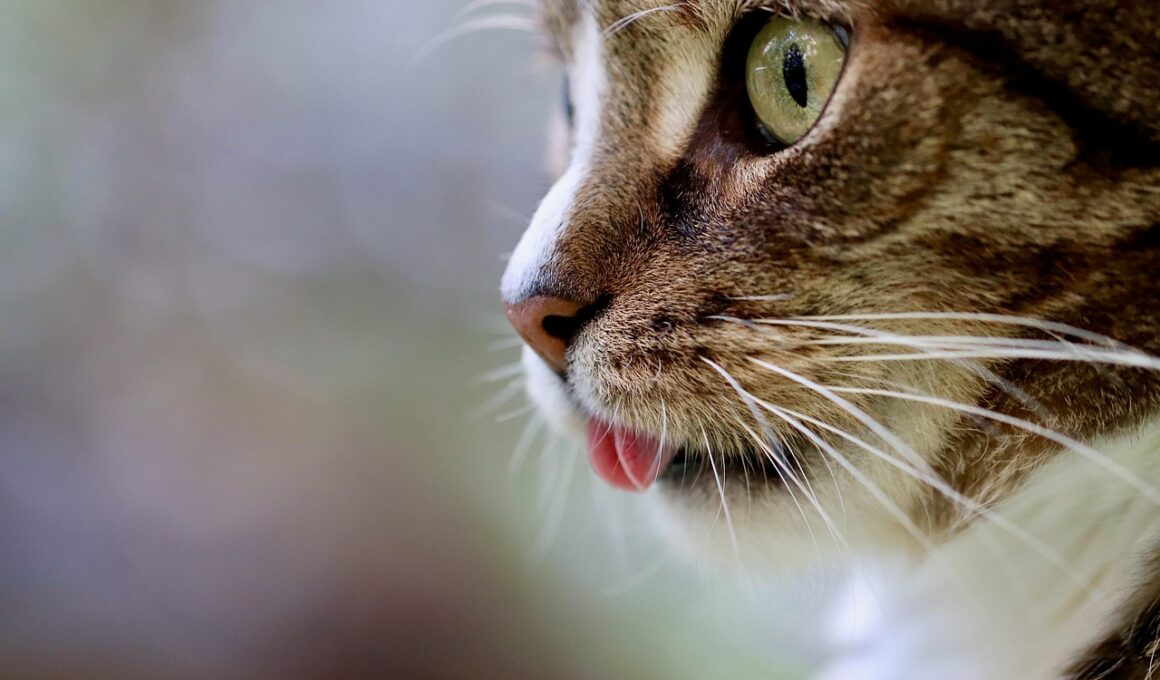How to Evaluate Your Cat’s Progress During Training
Evaluating your cat’s training progress is crucial to ensure that your training methods are effective. You can gauge their learning by observing their behavior changes over time. Each cat is unique, and their learning pace may vary, so it’s essential to be patient and consistent. A great approach is to note their responses during training sessions. Documenting improvement helps highlight successful techniques. Keep a journal of specific behaviors your cat has mastered. For instance, how quickly do they respond to commands like “sit” or “stay”? Additionally, consider setting achievable goals that can motivate both you and your cat. Training should be a fun and rewarding experience, creating a positive bond. If the cat frequently performs the behaviors successfully, they are likely understanding the commands. If progress seems slow, analyze your technique and consider modifications. Always reward positive behavior to reinforce learning. This positive reinforcement can effectively motivate your cat. Progress is not always linear, and setbacks may occur. Maintain a flexible mindset about your training expectations and adjust accordingly.
Another evaluation method involves assessing your cat’s body language and reactions to training stimuli. Observe for signs of confidence and comfort during training sessions. A relaxed body posture and eagerness to engage indicate that your cat is absorbing the lessons well. Underlying anxiety or discomfort, however, might suggest that the training approach isn’t suitable. Be mindful of stress signals, such as flattened ears or pacing. You may utilize visual aids like flashcards to stimulate learning and help your cat connect words with actions. Cats often learn better with tangible examples. Using a clicker is also beneficial, as it provides auditory reinforcement for correct behaviors. Furthermore, take note of how long your cat maintains focus during training. If they seem unfocused after a few minutes, consider shortening sessions and gradually increasing duration as they become more engaged and confident. Incorporate breaks to keep them motivated and enthusiastic. Introducing variety into your training exercises may also help in maintaining your cat’s attention. Always redirect unwanted behaviors with positive reinforcement, leading them towards the desired behavior instead of punishing them.
Tracking Behavioral Changes
Tracking behavioral changes is vital to understanding your cat’s training journey. Creating a log of behaviors before and after training sessions provides insights into their learning curve. You might observe the frequency of successful behaviors increase over time, indicating your cat is learning effectively. Frequent reward sessions paired with spontaneous playtime can reinforce the association between training and fun. Adjust your approach based on your observations regarding your cat’s mood and willingness to participate. Consider recording specific dates and noted improvements. For instance, is your cat progressing from occasional, half-hearted attempts to consistently performing commands reliably? Celebrate their milestones, no matter how small; this will enhance your cat’s self-esteem and encourage continual participation. Take photographs or videos of different training stages, celebrating your cat’s achievements. Visual documentation can be an enjoyable way to share successes with friends or fellow cat enthusiasts. Alongside tracking progress, ensure training methods remain playful and enjoyable for your cat, maintaining their enthusiasm. Be aware that learning may differ from one command to another, emphasizing individual strengths and weaknesses in specific areas.
Another useful way to evaluate progress is through testing. Structuring practice tests can help determine whether your cat has truly learned commands. Gradually increase the difficulty by introducing distractions or training in different environments. See how well your cat applies learned behaviors outside of the usual training settings; this will assess their understanding of commands. Resilience in any change of place or distractions can be a considerable sign of a successful training technique. If they can perform well even when challenged, that reveals accomplishment. Equally vital is recognition of areas where your cat struggles, guiding the necessary adjustments. Training should be tailored according to individual needs; thus, understanding these will aid in developing effective strategies and goals. Remind yourself that each cat learns differently, so patience is key. Always provide immediate feedback during tests, ensuring they connect their actions with consequences effectively. Often, cats may not grasp complex commands right away; slowly building up on simpler ones leads to eventual mastery. Consistent evaluation allows for recognition of progress and helps in maintaining motivation for both you and your feline friend.
Utilizing Positive Reinforcement
Positive reinforcement serves as the cornerstone of effective cat training. Rewarding your cat every time they execute a command correctly reinforces learning while fostering a healthy bond. Praise, treats, or playtime, depending on your cat’s preferences, can be excellent reward choices. Aim to use rewards immediately following a command, strengthening the connection between action and feedback. Consistency in using the same rewards ensures that your cat recognizes the cues and knows what to expect. Monitor your cat’s reactions to different types of rewards to determine which ones motivate them most. Variety within reinforcements also maintains interest and engagement in training sessions. Offering new treats or engaging in different games adds excitement while providing further motivation to learn. Positive reinforcement is particularly effective as it encourages not just obedience but a willingness to experiment and try different behaviors. This openness leads to a more fruitful learning environment. Avoid relying solely on treats, as incorporating play or affection can be equally motivating. Remember that training is a process, and patience, persistence, and respect for your cat’s uniqueness will yield great results.
Gauging your cat’s mental and emotional state is essential when evaluating training progress. Monitoring their comfort level during sessions provides an insight into their overall experiences with training. A cat that enjoys training is likely to show eagerness in participating regularly. Conversely, reluctance or signs of stress may indicate needing adjustments in strategy. Pay attention to changes in vocalization or body language throughout training. Are they more vocal, displaying excitement, or are they withdrawn? Building an enjoyable training routine encourages your cat to thrive and learn effectively. Your actions play a crucial role in this, so build a positive, relaxed atmosphere. Hold training sessions at opportune moments, ideally when your cat is calm and attentive. Too close to meal times or when they are sleepy can lead to distracted or non-directed behaviors. If your cat enjoys training, they will look forward to future sessions, fostering a cycle of positive engagement. Ultimately, adapting your methods based on your cat’s reactions is pivotal for success. Regular self-reflection on your techniques can also help ensure the training journey remains a positive experience.
Adjusting Training Strategies
Adapting your training strategies is necessary as your cat progresses. Flexibility in your approach enables you to respond to your cat’s needs and preferences. As your cat becomes more adept at certain commands, gradually increase the complexity of tasks. It’s essential not to overwhelm them with abrupt challenges. Breaking larger tasks into smaller, more manageable steps can help facilitate gradual learning while reducing frustration. Introduce new commands only when your cat has mastered previous ones. Be patient and allow sufficient time for your cat to assimilate concepts at their pace. Evaluating the training environment regularly is also vital; make changes where necessary to keep your cat engaged. Consistently interact without pressure, allowing your cat to explore and play while remaining focused on training tasks. Rotating locations for training sessions makes them feel fresh and exciting, reducing monotony. Use successful strategies you’ve identified to create engaging learning moments. Remember, every cat is a unique individual, and fostering their learning journey requires great attention and care. Assess their progress and joy during training regularly, adapting your strategies to continually support their growth.
Overall, evaluating your cat’s progress during training is an ongoing, engaging process. Committed observation, adaptation, and a focus on positive reinforcement create a fruitful learning environment. Both you and your feline companion can develop a trusting relationship and engage through training made fun. Documenting their progress and setbacks allows for a greater understanding of their unique learning styles. Therefore, consistency and flexibility are paramount to their success. Celebrate every achievement small or large, maintaining an enthusiastic spirit that fosters a positive training atmosphere. Engage in regular self-reflection, monitor changes in your cat’s behavior, and adjust accordingly to ensure effective learning. Empower your cat’s experience by utilizing different evaluation and reinforcement methods. By tweaking strategies, every cat can successfully learn their commands, or even tricks. With time, love, and patience, your training efforts can lead to a well-trained, confident cat. Ultimately, enjoy every stage of the training journey with your feline friend, as it fosters an inseparable bond and shared joy. Confirming their progress boosts motivation for all involved, ensuring long-term success and companionship in the beautiful world of cat training.


